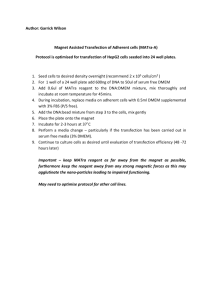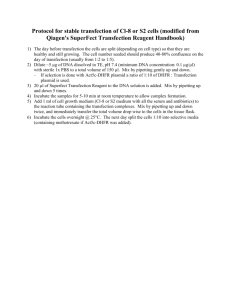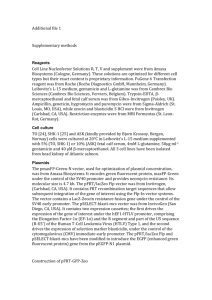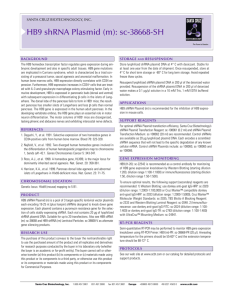Protocol 2 – Producing lentivirus in HEK293T cells using a 2
advertisement
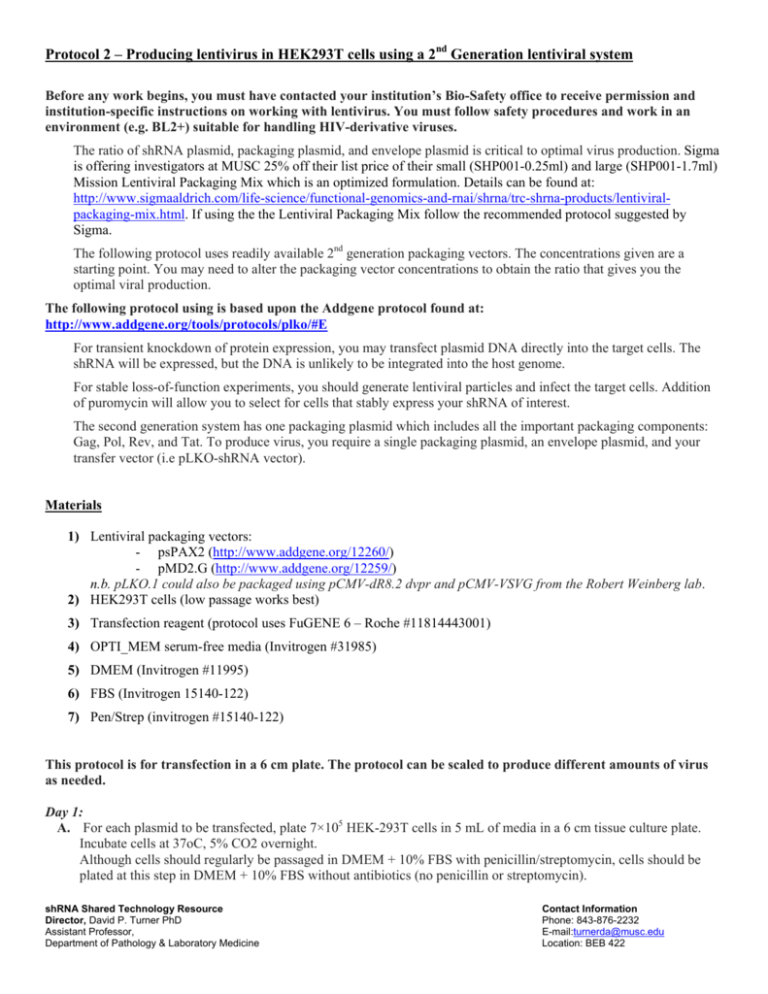
Protocol 2 – Producing lentivirus in HEK293T cells using a 2nd Generation lentiviral system Before any work begins, you must have contacted your institution’s Bio-Safety office to receive permission and institution-specific instructions on working with lentivirus. You must follow safety procedures and work in an environment (e.g. BL2+) suitable for handling HIV-derivative viruses. The ratio of shRNA plasmid, packaging plasmid, and envelope plasmid is critical to optimal virus production. Sigma is offering investigators at MUSC 25% off their list price of their small (SHP001-0.25ml) and large (SHP001-1.7ml) Mission Lentiviral Packaging Mix which is an optimized formulation. Details can be found at: http://www.sigmaaldrich.com/life-science/functional-genomics-and-rnai/shrna/trc-shrna-products/lentiviralpackaging-mix.html. If using the the Lentiviral Packaging Mix follow the recommended protocol suggested by Sigma. The following protocol uses readily available 2nd generation packaging vectors. The concentrations given are a starting point. You may need to alter the packaging vector concentrations to obtain the ratio that gives you the optimal viral production. The following protocol using is based upon the Addgene protocol found at: http://www.addgene.org/tools/protocols/plko/#E For transient knockdown of protein expression, you may transfect plasmid DNA directly into the target cells. The shRNA will be expressed, but the DNA is unlikely to be integrated into the host genome. For stable loss-of-function experiments, you should generate lentiviral particles and infect the target cells. Addition of puromycin will allow you to select for cells that stably express your shRNA of interest. The second generation system has one packaging plasmid which includes all the important packaging components: Gag, Pol, Rev, and Tat. To produce virus, you require a single packaging plasmid, an envelope plasmid, and your transfer vector (i.e pLKO-shRNA vector). Materials 1) Lentiviral packaging vectors: - psPAX2 (http://www.addgene.org/12260/) - pMD2.G (http://www.addgene.org/12259/) n.b. pLKO.1 could also be packaged using pCMV-dR8.2 dvpr and pCMV-VSVG from the Robert Weinberg lab. 2) HEK293T cells (low passage works best) 3) Transfection reagent (protocol uses FuGENE 6 – Roche #11814443001) 4) OPTI_MEM serum-free media (Invitrogen #31985) 5) DMEM (Invitrogen #11995) 6) FBS (Invitrogen 15140-122) 7) Pen/Strep (invitrogen #15140-122) This protocol is for transfection in a 6 cm plate. The protocol can be scaled to produce different amounts of virus as needed. Day 1: A. For each plasmid to be transfected, plate 7×105 HEK-293T cells in 5 mL of media in a 6 cm tissue culture plate. Incubate cells at 37oC, 5% CO2 overnight. Although cells should regularly be passaged in DMEM + 10% FBS with penicillin/streptomycin, cells should be plated at this step in DMEM + 10% FBS without antibiotics (no penicillin or streptomycin). shRNA Shared Technology Resource Director, David P. Turner PhD Assistant Professor, Department of Pathology & Laboratory Medicine Contact Information Phone: 843-876-2232 E-mail:turnerda@musc.edu Location: BEB 422 Protocol 2Day 2: B. Perform the transfection in the late afternoon because the transfection mix should only be incubated with the cells for 12-15 hours. C. In polypropylene microfuge tubes (do NOT use polystyrene tubes), make a cocktail for each transfection: 1 μg pLKO.1 shRNA plasmid 750 ng psPAX2 packaging plasmid 250 ng pMD2.G envelope plasmid to 20 μl serum-free OPTI-MEM The ratio of shRNA plasmid, packaging plasmid, and envelope plasmid is critical to optimal virus production. You may need to alter the concentrations to obtain the ratio that gives you the optimal viral production. D. Create a master mix of FuGENE® 6 transfection reagent in serum-free OPTI-MEM. Calculate the amount of Fugene® and OPTI-MEM necessary given that each reaction will require 6 μL FuGENE® + 74 μL OPTI-MEM. For example: 1x master mix: 6 μL FuGENE® + 74 μL OPTI-MEM 5x master mix: 30 μL FuGENE® + 370 μL OPTI-MEM 10x master mix: 60 μL FuGENE® + 740 μL OPTI-MEM In a polypropylene tube, add OPTI-MEM first. Pipette FuGENE® directly into the OPTI-MEM – do not allow FuGENE® to come in contact with the walls of the tube before it has been diluted. Mix by swirling or gently flicking the tube. Incubate for 5 minutes at room temperature. E. F. G. H. I. Add 80 μL of FuGENE® master mix to each tube from step c for a total volume of 100 μL. Pipette master mix directly into the liquid and not onto the walls of the tube. Mix by swirling or gently flicking the tube. Incubate for 20-30 minutes at room temperature. Retrieve HEK-293T cells from incubator. The cells should be 50-80% confluent and in DMEM that does not contain antibiotics. Without touching the sides of the dish, gently add DNA:FuGENE® mix dropwise to cells. Swirl to disperse mixture evenly. Do not pipette or swirl too vigorously, as you do not want to dislodge the cells from the plate. Incubate cells at 37°C, 5% CO2 for 12-15 hours. Day 3: J. In the morning, change the media to remove the transfection reagent. Replace with 5 mL fresh DMEM + 10% FBS + penicillin/streptomycin. Pipette the media onto the side of the plate so as not to disturb the transfected cells. K. Incubate cells at 37°C, 5% CO2 for 24 hours. Day 4: L. Harvest media from cells and transfer to a polypropylene storage tube. The media contains your lentiviral particles. Store at 4°C. M. Add 5 mL of fresh media containing antibiotics to the cells and incubate at 37°C, 5% CO2 for 24 hours. Day 5: N. Harvest media from cells and pool with media from Day 4. Spin media at 1,250 rpm for 5 minutes to pellet any HEK-293T cells that were inadvertently collected during harvesting. In lieu of centrifugation, you may filter the media through a 0.45 μm filter to remove the cells. Do not use a 0.2 μm filter, as this is likely to shear the envelope of your virus. O. Virus may be stored at 4°C for a few days, but should be frozen at -20°C or -80°C for long-term storage. Freeze/thaw cycles decrease the efficiency of the virus, so Addgene recommends that you use the virus immediately or aliquot the media into smaller tubes to prevent multiple freeze/thaw cycles. shRNA Shared Technology Resource Director, David P. Turner PhD Assistant Professor, Department of Pathology & Laboratory Medicine Contact Information Phone: 843-876-2232 E-mail:turnerda@musc.edu Location: BEB 422


